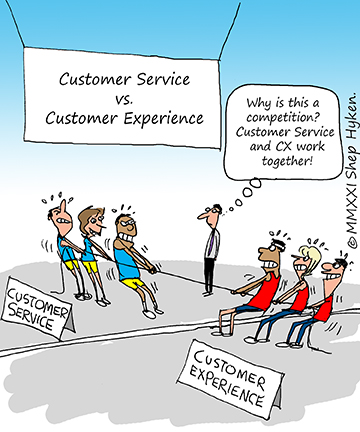 It is one of the most common questions I’m asked in interviews: What’s the difference between customer service and customer experience (also known as CX)?
It is one of the most common questions I’m asked in interviews: What’s the difference between customer service and customer experience (also known as CX)?
Key Takeaways: Customer Service Versus Customer Experience
- Customer service is part of customer experience (CX), but CX encompasses every interaction with a company, beyond just service.
- The concept of customer experience has evolved to include all aspects of a company’s interaction with a customer, such as website navigation, promotional communications, and even product unboxing.
- Effective customer service is essential when issues arise, but customer service philosophies should be adopted company-wide, not just within a support department.
- CX aims to create positive, holistic experiences that include, but are not limited to, solving problems and answering questions.
Understanding the Difference Between CX and Customer Service
While I’ve written about this before, my original article about customer experience was more about how to create a more interactive experience.
The example I used was how Home Shopping Network (HSN) incorporated gamification into the customer experience. It offered games and puzzles on its website. The prize for winning the game or solving the puzzle was in the form of discounts.
That’s a great – and even fun – experience, but there is much more to it than that.
First, a little history.
I remember the term customer experience being used as a fancy phrase to describe customer service. Many years ago, that’s all it was. Some smart person was trying to give a facelift to the term customer service.
Not long after that, however, other smart people started using the term customer experience to describe every interaction with a company. That included customer service and much more.
This is where it confuses some people.
The Real Comparison: Customer Service vs. Customer Experience
Customer service is part of customer experience, but customer experience goes to a much broader level.
Some of the obvious experiences include navigating a website, reading promotional emails and text messages, watching the brand’s videos and much more. Even opening a package is part of the customer experience.
Think about how cool it is to unbox an iPhone or iPad. Back in the day, Steve Jobs was very specific about how he wanted the unboxing of the company’s products to be an amazing CX.
Some say that customer service is what happens when the customer experience goes wrong.
That’s part of it, but it’s not the whole picture. If you’ve followed my work, you know that customer service is not a department that deals with problems and complaints. It’s a philosophy to be embraced by every employee, from the CEO or owner to the most recently hired. It’s how you interact with people, both your internal and external customers.
The customer support department deals with questions, problems and complaints. Of course, their customer service skills must be at the highest level when dealing with unhappy customers and solving problems.
Maximizing Positive Customer Interactions
Creating positive customer interactions is pivotal for sustaining and growing any business.
Every touchpoint, from the initial contact through to post-purchase support, offers a chance to leave a lasting impression. Here are strategies to ensure these interactions not only meet but exceed customer expectations:
- Understand Your Customers: Start by gathering as much information as possible about your customers. Use data analytics, surveys, and direct feedback to comprehend their needs, preferences, and pain points. This knowledge enables personalized interactions that resonate with customers on an individual level.
- Empower Your Team: Equip your team with the necessary tools, training, and autonomy to make customer-focused decisions. When employees feel empowered, they are more likely to go the extra mile to solve customer issues effectively and proactively.
- Foster Emotional Connections: Beyond solving problems, strive to connect with your customers emotionally. Simple gestures, such as remembering a customer’s name or sending a personalized thank you note, can transform a standard interaction into a memorable experience.
- Leverage Technology Wisely: While technology, like chatbots and AI, can streamline operations, it’s crucial to maintain a human touch. Use technology to enhance customer service, not replace it. Ensure that customers can easily reach a human when needed, particularly for complex issues.
- Be Proactive: Anticipate customer needs and address them before they turn into problems. This could be as simple as sending reminders for renewals or as complex as using predictive analytics to offer tailored recommendations.
- Consistency Across Channels: Ensure that the quality of customer service is uniform across all platforms, whether it’s in-store, online, or through social media. Consistency builds trust and reinforces your brand’s reliability.
- Train for Active Listening: Encourage your team to practice active listening. Understanding the underlying sentiments behind a customer’s words can lead to more effective solutions and demonstrates that you value their input.
- Quick and Efficient Resolution: Speed and efficiency are crucial. However, quick resolutions should not compromise the quality of service. Implement strategies that allow your team to address concerns swiftly without making the customer feel rushed.
- Follow-up: A follow-up after resolving a customer’s issue shows that you care about their satisfaction in the long term. It also provides an opportunity to rectify any unresolved issues and gather valuable feedback.
- Create a Feedback Loop: Use customer feedback to continually refine and improve your service. This not only enhances the customer experience but also demonstrates that you value and act upon their opinions.
Wrapping Up
So, a short definition of customer service is all of the interactions that customers have with the people in the company. We can even broaden that to digital interactions, which now include chatbots, interactive experiences on a website and more. Just to emphasize, these interactions include, but go beyond, the interactions for customer support.
Customer experience includes customer service – and everything else a customer might experience when doing business with you.